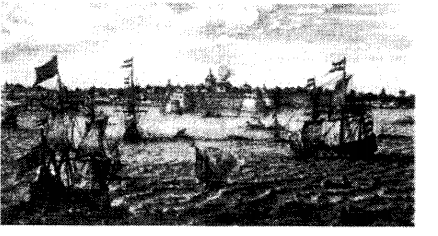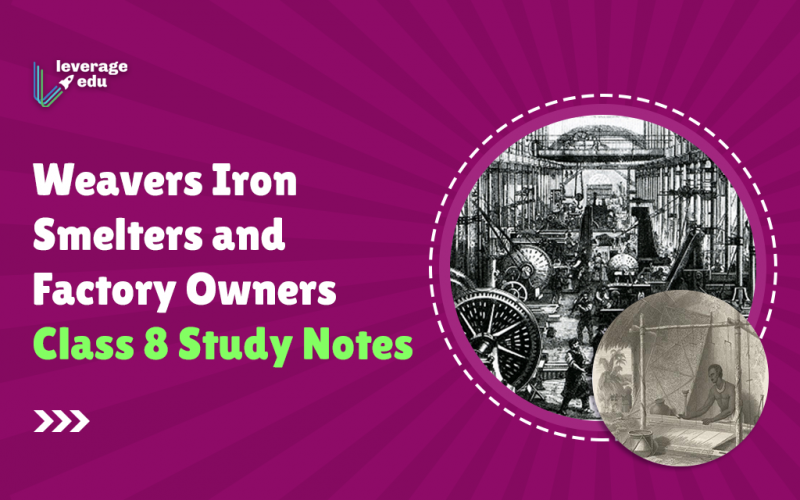History is an important subject of the class 8 syllabus. In this blog, we shall discuss chapter 7 of class 8 History – Ruling the Countryside. This chapter deals with weavers, .iron smelters and factory owners of history. In this blog, you will find a comprehensive understanding of weavers, iron smelters and factory owners Class 8 Notes.
This Blog Includes:
- Weavers, Iron Smelters and Factory Owners
- Indian Textile- Influence on World Market
- Indian Textile and its influence on European Market
- Weavers, Iron Smelters and Factory Owners: The Decline of Indian Textiles
- Establishment of Cotton Mills
- Weavers, Iron Smelters and Factory Owners: Wootz Steel
- Iron and Steel Factories
- Questions on Weavers, Iron Smelters and Factory Owners
Weavers, Iron Smelters and Factory Owners

During the British era, industries in India were primarily of two types – textiles, iron, and steel. The industrialization of Britain was closely connected to the colonization of India. Although India was a leading nation in terms of craft and trade, with the advent of the industrial revolution, Britain came to be known as the “Workshop of the World” and British industrialists saw India as a market with great potential for industrial products.
Indian Textile- Influence on World Market
- In the 1750s, India was the largest producer of cotton textiles in the world.
- Indian textile was globally recognised for fine quality and exquisite craftsmanship and hence from 16th C onwards European traders started buying Indian textiles for Europe.
- Indian Textiles were popular under the name of ‘muslin’ and ‘calico’ in the world market.
- Printed cotton cloths were called “chintz” produced in Andhra Pradesh, Masulipatnam and Bandanna produced in Gujarat and Rajasthan.
- While patola was famous in Surat and Ahmedabad, Jamdani was famous in Bengal.
Check Notes on:
- Tribals, Dikus and the Vision of a Golden Age Class 8 Notes
- From Trade to Territory Class 8 Study Notes
- How When and Where Class 8
- Ruling the Countryside Class 8 Notes
Indian Textile and its influence on European Market
- ‘Calico Act’ was enacted in 1720 by the British government that banned the use of printed cotton textiles – Chintz in England.
- John Kaye invented spinning jenny in 1764 and with the invention of the steam engine, cotton textile weaving was revolutionised in 1786 by Richard Arkwright.
- In England, Indian designs were printed on white muslin or plain unbleached cloth.
- The famous weaving centers were located in – Calicut, Gujarat, Bengal and Andhra Pradesh.
- Weavers belonged to communities of – Tanti in Bengal, Julakas or momin in North India, Kaikolars and Devangs in South India.
- Occupations associated with the handloom weaving sector provided livelihood for millions of Indians.
Weavers, Iron Smelters and Factory Owners: The Decline of Indian Textiles
- The development of cotton industries in Britain affected textile producers in India.
- By the beginning of the 19th century, English-made cotton textiles successfully replaced Indian goods from their traditional markets in Africa, America, and Europe. Even, English and European companies stopped buying Indian goods.
- British cotton cloth flooded Indian markets by the 1830s and thousands of rural women were rendered jobless.
- During the National movement, Mahatma Gandhi urged people to boycott imported textiles and use hand-spun and hand woven cloth, Khadi became a symbol of nationalism.
Check Notes on:
Establishment of Cotton Mills
- The first cotton mill was established in 1854 in Bombay.
- Nearly 84 mills were functional in Bombay, however, the colonial government did not support mill advancement by denying import duty.
- The first major development, in the case of cotton factory production was during the first world war because of the decline of imports from British Industry and hence, Indian factories were asked to work.
Weavers, Iron Smelters and Factory Owners: Wootz Steel
- Wootz was a high quality carbon steel produced all over South India and was used to manufacture swords.
- This fascinated European Scientists and the Wootz steel making process was known all over South India.
- However, with the arrival of British, the swords and armour making industry collapsed as iron and steel from Britain replaced the need.
- The production of wootz steel was a highly specialised way of refining iron and by the late 19th C, the craft of iron smelting declined because of the imposition of forest protection laws in India by the British. As a result, artisans producing iron and steel faced a severe competition.
Iron and Steel Factories

- Charles Weld, an American geologist and Dorabji Tata together set up a modern iron and steel plant in India in 1904.
- In 1912, TISCO was established and it started producing steel.
- After 2 years of TISCO, the First World War occured in 1914 and imports of steel declined. As a result of this, Indian Railways asked TISCO for supply of rails and thus, TISCO was established as the biggest steel industry within the British empire.
Check Notes on:
- Notice Writing for Class 8
- NCERT Class 8 SST Syllabus
- List of NCERT Books Class 8
- Class 8 English
- NCERT Class 8 Maths Syllabus
Questions on Weavers, Iron Smelters and Factory Owners
Now that you are through with the Ruling the Countryside class 8 notes, test your knowledge with these questions:
Chintz (chhint), Cossaes (Khassa) and Bandanna. Bandanna word was derived from the word bandhan . It referred to a variety of brightly coloured cloth, produced through a method of tying and dying.
Jamdani is a fine muslin on which decorative motifs are woven on the loom, typically in grey and white.
Bandanna is a brightly coloured and printed scarf for neck and head. This word was derived from the word Bandhan. It referred to a variety of brightly coloured cloth, produced through a method of tying and dying.
Groups of men and women carrying basket-loads of iron are known as the Agarias.
a. The word chintz comes from the word ________
b. Tipu’s sword was made of _____ steel.
c. India’s textile exports declined in the _____ century.
Ans.
a. chintz
b. Wootz
c. 19th.
So, this was all about Weavers, Iron Smelters and Factory Owners Class 8 notes. Hope you found this helpful for your exam preparation. For more such content, stay connected with Leverage Edu!

 One app for all your study abroad needs
One app for all your study abroad needs





















 45,000+ students realised their study abroad dream with us. Take the first step today.
45,000+ students realised their study abroad dream with us. Take the first step today.

